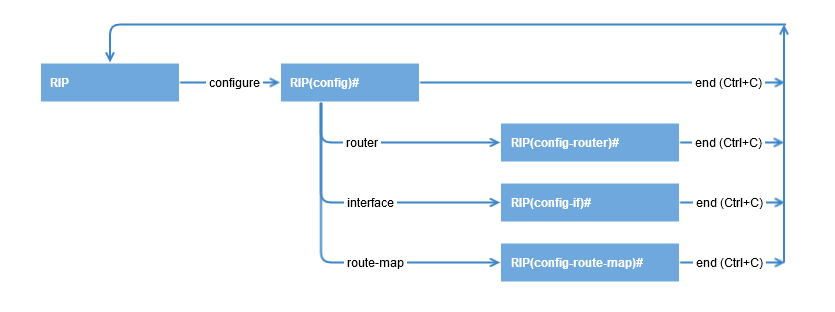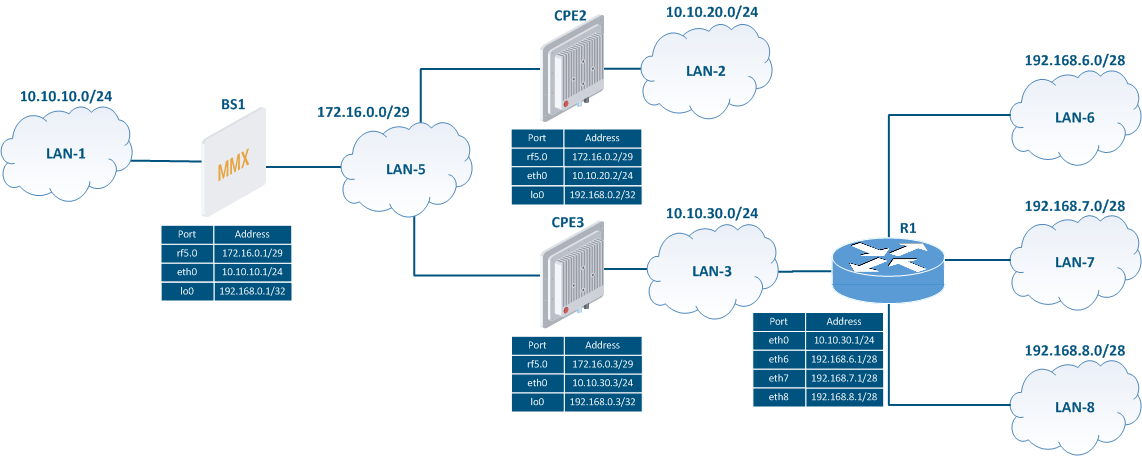Table of content
Description
The InfiNet devices of the InfiLINK 2x2 and InfiMAN 2x2 families have two modules for configuring RIP: rip and arip. The difference between them is in the interoperability with the OSPF protocol, which is not present in the rip module, thus it is recommended to configure the devices using the arip module. Due to the recommendation, this article will describe RIP configuration using the arip module.
The RIP configuration is performed only via CLI. A separate command shell with several modes is used to configure the RIP protocol (Figure 1). The transition to each mode is performed using the commands with the same name. A detailed commands description is available in Technical documentation.
| Mode name | Description |
|---|---|
| Basic | Basic RIP mode is used to analyze the diagnostic commands output and switch to configuration mode. Switching to basic mode is performed from the WANFleX command shell using the "arip" command. BS_1#1> arip RIP> |
| RIP configuration | Configuration mode allows to manage the RIP service running on the device and proceed to the configuration modes, router, interfaces, or route-maps. Switching to RIP configuration mode is performed from basic mode using the "config" command. RIP> config RIP(config)# |
| RIP router configuration | In router configuration mode, basic RIPF settings are made. The mode allows to configure the announced networks, router ID, etc. Switching to the RIP router configuration mode is performed from the configuration mode using the "router" command. RIP(config)# router RIP(config-router)# |
| RIP interface configuration | RIP interface configuration mode allows to configure the protocol settings related to a specific interface. Switching to the RIP interface configuration mode is performed from the configuration mode using the "interface IFNAME" command. RIP(config)# interface rf5.0 RIP(config-if)# |
| Route-maps configuration | Route-maps configuration mode allows to configure the rules that should be applied to announced or received RIP routes. Switching to the RIP route-map configuration mode is performed from the configuration mode using the rule creation command "route-map WORD (deny|permit) <1-65535>". RIP(config)# route-map MAP permit 10 RIP(config-route-map)# |

Each RIP shell modes provides help by displaying the full list of supported commands. To display the list use the "help" command.
The routing table can be displayed by the following commands:
Из командной оболочки WANFleX: BS_1#1> netstat -r Из командной оболочки RIP: RIP> show route Из командной оболочки ARDA: ARDA> show route
Task
Let's look at the RIP step by step configuration on Infinet devices using the following scheme (Figure 2):
- the network consists of three wireless devices BS1, CPE2 and CPE3 connected by wireless links;
- бsubnet 172.16.0.0/29 is assigned to the wireless network;
- each wireless device has a connection to a wired segment: BS1 is connected to the 10.10.10.0/24 network, CPE2 - to the 10.10.20.0/24 network, CPE3 - to the 10.10.30.0/24 network;
- three static routes are configured on the CPE3 wireless device to the networks 192.168.6.0/28, 192.168.7.0/28, 192.168.8.0/28. The third-party router R1 is used as a gateway;
- to the loopback interface of each wireless device is assigned an address from the 192.168.0.0/24 network.
Task: configure the RIP operation on wireless devices to add information about all the networks in the scheme to the routing table of each router. The BS1 device should be used as the default gateway on the CPE2 and CPE3 devices.
Figure 2 - Network scheme for RIP configuring example
Solution
Perform the devices step by step configuration in accordance with the task. In addition to the RIP configuration, the static routing will be used (see. Static routing) for connection with LAN-6, LAN-7, LAN-8.
To demonstrate more features in the example, different approaches will be used to configure RIP on wireless devices.
Pre-configuration
| Description | Perform a devices preliminary configuration consisting of the following steps:
|
|---|---|
| BS1 | Set device ID system prompt BS_1 Remove svi1 interface ifc svi1 destroy Assign IP addresses ifc eth0 10.10.10.1/24 ifc rf5.0 172.16.0.1/29 ifc lo0 192.168.0.1/32 Disable switching switch stop Set radio link rf rf5.0 band 20 rf rf5.0 freq 5000 mint rf5.0 -name "BS_1" mint rf5.0 -type master |
| CPE2 | Set device ID system prompt CPE_2 Remove svi1 interface ifc svi1 destroy Assign IP addresses ifc eth0 10.10.20.2/24 ifc rf5.0 172.16.0.2/29 ifc lo0 192.168.0.2/32 Disable switching switch stop Set radio link mint rf5.0 -name "CPE_2" mint rf5.0 -type slave mint rf5.0 prof 1 -band 20 -freq 5000 -type slave |
| CPE3 | Set device ID system prompt CPE_3 Remove svi1 interface ifc svi1 destroy Assign IP addresses ifc eth0 10.10.30.3/24 ifc rf5.0 172.16.0.3/29 ifc lo0 192.168.0.3/32 Add static routes route add 192.168.5.0/28 10.10.30.1 route add 192.168.6.0/28 10.10.30.1 Disable switching switch stop Set radio link mint rf5.0 -name "CPE_3" mint rf5.0 -type slave mint rf5.0 prof 1 -band 20 -freq 5000 -type slave |
RIP configuration
| Description | Configure the RIP protocol in accordance with the scheme. Step 1: start RIP daemon. Step 2: define the interfaces where RIP should be started:
In the CPE2 router configuration, the range of networks used in RIP will be set as a single entry 0.0.0.0/0. This entry includes all networks and enables RIP support on all router interfaces; when some device interfaces is connected to a new network, this network will be immediately announced via RIP. This approach doesn't require additional RIP configuration, but decreases control over announcements. On the BS1 and CPE3 routers, we will be set only those networks that are associated with the interfaces participating in the RIP operation. Step 3: make redistribution of directly connected networks on the BS1 router and static routes on the CPE3 router. Step 4: configure passive interfaces. The CPE3 eth0 interface is connected to the outside router R1, therefore it is necessary to block the routing information transmission between them. To ensure this, the CPE3 eth0 interface must be configured as passive. Step 5: announce the default route, specifying BS1 as the gateway. |
|---|---|
| BS1 | Start RIP daemon arip start Start RIP on interfaces arip config router network 172.16.0.0/29 Connected routes redistribution arip config router redistribute connected Default route announcement arip config router default-information originate |
| CPE2 | Start RIP daemon arip start Start RIP on interfaces arip config router network 0.0.0.0/0 |
| CPE3 | Start RIP daemon arip start Start RIP on interfaces arip config router network 10.10.30.0/24 network 172.16.0.0/29 network 192.168.0.3/32 Static routes redistribution arip config router redistribute kernel Passive interfaces configuration passive-interface eth0 |
Command output analyzing
Routing table
| Description | The routing tables of wireless devices, contains entries that each device has information about each subnet shown in the scheme. This means that the devices have successfully exchanged routing information and added it to the FIB. Note the devices routing table contains a route to the addresses assigned to the loopback interfaces of other wireless devices. These interfaces have been added to RIP in various ways:
Also pay attention to the default route on CPE2 and CPE3 devices. in accordance with the configuration, BS1 announces the default route to all devices that support RIP, indicating itself as a gateway. At the same time, the default route is absent in the BS1 routing table. The CPE3 router redistributes static routes, therefore, the BC1 and CPE2 routing tables contain paths to the networks 192.168.6.0/24, 192.168.7.0/24 and 192.168.8.0/24. |
|---|---|
| BS1 | BS_1#1> netstat -r Routing tables Destination Gateway Flags Refs Use Interface 10.10.10.0/24 link#2 UC 0 0 eth0 10.10.20.0/24 172.16.0.2 UG3 0 0 rf5.0 10.10.30.0/24 172.16.0.3 UG3 0 0 rf5.0 127.0.0.1 127.0.0.1 UH 3 106 lo0 172.16.0.0/29 link#3 UC 0 0 rf5.0 192.168.0.1 192.168.0.1 UH 0 0 lo0 192.168.0.2 172.16.0.2 UGH3 0 0 rf5.0 192.168.0.3 172.16.0.3 UGH3 0 0 rf5.0 192.168.6.0/28 172.16.0.3 UG3 0 0 rf5.0 192.168.7.0/28 172.16.0.3 UG3 0 0 rf5.0 192.168.8.0/28 172.16.0.3 UG3 0 0 rf5.0 224.0.0.0/8 127.0.0.1 UGS 0 346 lo0 |
| CPE2 | AS_2#1> netstat -r Routing tables Destination Gateway Flags Refs Use Interface default 172.16.0.1 UG3 0 0 rf5.0 10.10.10.0/24 172.16.0.1 UG3 0 0 rf5.0 10.10.20.0/24 link#2 UC 0 0 eth0 10.10.30.0/24 172.16.0.3 UG3 0 0 rf5.0 127.0.0.1 127.0.0.1 UH 3 100 lo0 172.16.0.0/29 link#3 UC 0 0 rf5.0 192.168.0.1 172.16.0.1 UGH3 0 0 rf5.0 192.168.0.2 192.168.0.2 UH 0 0 lo0 192.168.0.3 172.16.0.3 UGH3 0 0 rf5.0 192.168.6.0/28 172.16.0.3 UG3 0 0 rf5.0 192.168.7.0/28 172.16.0.3 UG3 0 0 rf5.0 192.168.8.0/28 172.16.0.3 UG3 0 0 rf5.0 224.0.0.0/8 127.0.0.1 UGS 0 703 lo0 |
| CPE3 | AS_3#1> netstat -r Routing tables Destination Gateway Flags Refs Use Interface default 172.16.0.1 UG3 0 0 rf5.0 10.10.10.0/24 172.16.0.1 UG3 0 0 rf5.0 10.10.20.0/24 172.16.0.2 UG3 0 0 rf5.0 10.10.30.0/24 link#2 UC 0 0 eth0 127.0.0.1 127.0.0.1 UH 3 84 lo0 172.16.0.0/29 link#3 UC 0 0 rf5.0 192.168.0.1 172.16.0.1 UGH3 0 0 rf5.0 192.168.0.2 172.16.0.2 UGH3 0 0 rf5.0 192.168.0.3 192.168.0.3 UH 0 0 lo0 192.168.6.0/28 10.10.30.1 UGS 0 0 eth0 192.168.7.0/28 10.10.30.1 UGS 0 0 eth0 192.168.8.0/28 10.10.30.1 UGS 0 0 eth0 224.0.0.0/8 127.0.0.1 UGS 0 349 lo0 |
